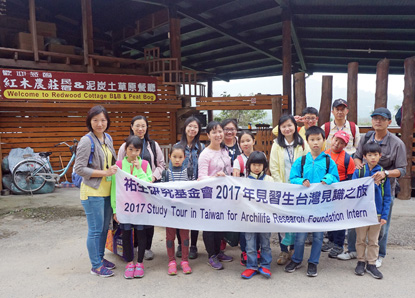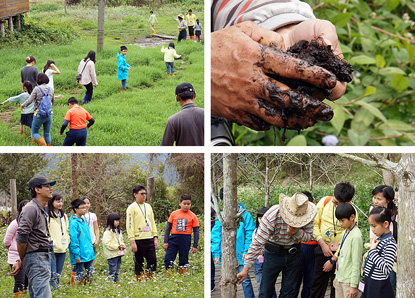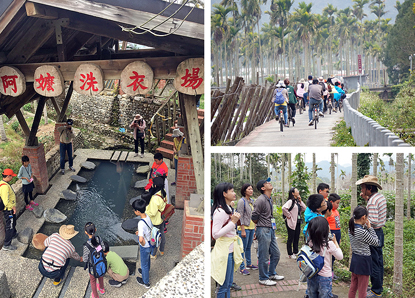Sketch of Archilife Study Tour, March 2017Date: 2017-04-19
Section: Activity |  3月份見識之旅活動,於2017年3月18日由呂明澐小姐帶領13位祐生見習生及家長們,進行日月潭活盆地暨水土保持教育之旅。出發當日台北天氣晴朗,見習生們及其家長準時集合並出發。活動開始之初,領隊呂明澐小姐提醒本次活動注意事項及觀察重點,先行為見習生建立泥炭土的背景知識。 3月份見識之旅活動,於2017年3月18日由呂明澐小姐帶領13位祐生見習生及家長們,進行日月潭活盆地暨水土保持教育之旅。出發當日台北天氣晴朗,見習生們及其家長準時集合並出發。活動開始之初,領隊呂明澐小姐提醒本次活動注意事項及觀察重點,先行為見習生建立泥炭土的背景知識。
For the study tour of March 18, 2017, Ms. Lu Ming-yun led 13 ARF interns and their parents on an educational tour to learn about soil and water conservation in the Sun Moon Lake Peat Soil Basin. It was clear and sunny in Taipei on the day of the tour, and the interns and their parents were on time for the departure. At the start of the day's activities, team leader Ms. Lu Ming-yun reminded everyone about things to note and what to observe, and provided the interns some general background knowledge about peat soil in Nantou.
 本次上午活動行程參訪紅木農莊,其位於南投縣魚池鄉的泥炭土盆地,由農莊主人吳明堤教授擔任導覽老師。行程一開始,導覽老師透過投影放映講解日月潭周邊生態環境及當地的發展變遷,並以圖示對比今昔差異,為眾人建立基本概念。 本次上午活動行程參訪紅木農莊,其位於南投縣魚池鄉的泥炭土盆地,由農莊主人吳明堤教授擔任導覽老師。行程一開始,導覽老師透過投影放映講解日月潭周邊生態環境及當地的發展變遷,並以圖示對比今昔差異,為眾人建立基本概念。
The day's tour started with the Redwood Cottage located in the peat soil basin of Yuchih Township, Nantou County. The cottage owner Professor Wu Ming-ti was the tour guide. Using slides, Professor Wu explained the ecology surrounding Sun Moon Lake, and development and changes in the locality, and compared the past and present by using illustrations, establishing the basic concept for everyone.
隨即以泥炭土為主軸,介紹其優於海綿的吸水特性,以及可做為燃料、發電、園藝介質與防蚊等用途,亦說明泥炭土生成係以每年幾毫米的速度緩慢積累,頭社盆地的泥炭土面積廣達174公頃,深度超過80公尺,至今僅餘農莊內的泥炭土保留完整原貌,其珍貴性可見一斑。緊接著導覽老師帶領眾人走入活盆地,實地體驗立於浮田之上波浪般的律動,見習生對於如此特殊的體驗皆興奮不已。
Next, he introduced the sponge-like absorbability of peat soil, and its use as fuel, for power generation, as gardening medium and for mosquito prevention. He also explained that peat soil accumulates at a slow rate of several millimeters per year. Peat soil in the Toushe Basin covers an area of 174 hectares and is over 80 meters in depth. Today, only the peat soil in the farm area around the cottage remains intact, making it extremely precious. Professor Wu then took everyone into the peat soil basin to experience the wave-like movement of the field. The interns were all thrilled by the unique experience.
 午餐於紅木農莊享用活盆地風味餐,食材皆為當地盛產的時令蔬果與在地養殖的活魚,餐點鮮美可口。飯後,隨即進行泥炭土寶寶手做DIY,以泥炭土做為介質,倒入些許果嶺草種子再加以塑型,完成後可藉由後續照顧觀察其生長情形,並了解毛細現象之作用。 午餐於紅木農莊享用活盆地風味餐,食材皆為當地盛產的時令蔬果與在地養殖的活魚,餐點鮮美可口。飯後,隨即進行泥炭土寶寶手做DIY,以泥炭土做為介質,倒入些許果嶺草種子再加以塑型,完成後可藉由後續照顧觀察其生長情形,並了解毛細現象之作用。
Lunch at the Redwood Cottage consisted of seasonal vegetables and fruits grown locally, and fresh fish reared in the local fish farm. After lunch, everyone participated in a DIY activity using peat soil, which was mixed with turf-grass seeds and shaped into little figurines. The interns were told to bring them home and observe their growth to understand the capillarity action.
 行程最後,以騎乘自行車的方式,順著環村自行車道,於頭社村做生態文化巡禮,沿途經過舊式洗衣場、當地信仰中心--「三聖宮」及檜木碾米機等,導覽老師詳細解說頭社盆地現今農業概況、發展及眼前所見的農作物,使見習生深入了解傳統農業社會務農使用的器具及生活型態。導覽老師全程以詼諧幽默的口吻解說,為本次行程增添活潑氣氛。至此,本日活動已近尾聲,大家一起合照留念後各自返家,並期待於下次見識之旅再相見。 行程最後,以騎乘自行車的方式,順著環村自行車道,於頭社村做生態文化巡禮,沿途經過舊式洗衣場、當地信仰中心--「三聖宮」及檜木碾米機等,導覽老師詳細解說頭社盆地現今農業概況、發展及眼前所見的農作物,使見習生深入了解傳統農業社會務農使用的器具及生活型態。導覽老師全程以詼諧幽默的口吻解說,為本次行程增添活潑氣氛。至此,本日活動已近尾聲,大家一起合照留念後各自返家,並期待於下次見識之旅再相見。
The tour ended with a cycling trip around the Toushe Village, passing an old-style laundry, the Three-Saint Temple (the religious center for the locals) and cypress-wood rice husker. Professor Wu gave an overview of the agricultural industry in the Toushe Basin and explained about the crops grown in the locality, allowing interns to understand equipment used in traditional farming society and its way of living. Professor Wu's humorous tone of voice greatly enlivened the entire tour. At that point, the day's itinerary came to an end. Everyone returned to home after taking a group photo and looked forward to the next study tour.
|
|